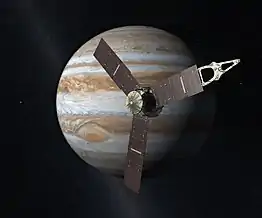2MASS J1119–1137
2MASS J11193254–1137466 (AB)[2] (often shortened to 2MASS J1119–1137) is a planetary mass binary[3][4] located 86±23 light-years from the Earth[3] in the constellation Crater. The components of 2MASS J1119–1137 are each roughly four Jupiter masses. The exoplanet is probably a part of the TW Hydrae association which has an age of approximately 10 million years.[3][5]
| Observation data Epoch J2000 Equinox J2000 | |
|---|---|
| Constellation | Crater |
| Right ascension | 11h 19m 32.543s[1] |
| Declination | −11° 37′ 46.70″[1] |
| Characteristics | |
| Evolutionary stage | Sub-brown dwarf |
| Spectral type | L7red[1] |
| Apparent magnitude (H) | 15.61±0.14[1] |
| Apparent magnitude (K) | 14.62±0.11[1] |
| Details | |
| Mass | ~5-10 MJup |
| Luminosity (bolometric) | 0.00004 solar units (total luminosity) L☉ |
| Other designations | |
WISE J111932.43-113747.7 | |
| Database references | |
| SIMBAD | data |
| Discovery | |
|---|---|
| Discovery date | 2016 |
| Imaging | |
| Designations | |
| WISE J111932.43-113747.7, 2MASS J11193254-1137466 | |
| Orbital characteristics | |
| 3.6 ± 0.9 a.u. | |
| 90+80 −50 years | |
| Physical characteristics | |
| Mass | ~5–10 MJ |
Spectral type | L7red |
Overview
The object was found by a team of scientists from Canada, USA and Chile during a search for unusually red brown dwarfs (such color indicates some notable properties of their atmospheres, e.g. dustiness). The search used data of 3 surveys: SDSS (visible light data), 2MASS (near-infrared) and WISE (mid-wave infrared). 2MASS J1119–1137 was one of the reddest and, according to the authors, the most interesting object found. Results of the work were published in December 2015.[6]
In April 2016, the first detailed study of the object was published. The investigators conducted its infrared spectroscopy on the telescope Gemini South. Radial velocity and proper motion were also calculated. The astronomers determined low surface gravity and moderate age of 2MASS J1119–1137.[5][7]
In November 2016 and March 2017, 2MASS J1119–1137 was imaged by the telescope Keck II with adaptive optics technique, which revealed its binarity. The angular separation of components is 0.13788 ± 0.00034 arcseconds (which corresponds to linear projected separation 3.6 ± 0.9 a.u.). Their stellar magnitudes are roughly equal. Total mass of the system is estimated as 7.4+2.5
−1.9 Jupiter masses. Their total bolometric luminosity is approximately 0.00004 solar units. The estimated orbital period is 90+80
−50 years.[3]
One of the components of binary is rotating rapidly, having a period 3.02+0.04
−0.03 hours while the typical rotation period for young brown dwarfs is 10 hours.[8]
External links
| External video | |
|---|---|
- 2MASS J1119–1137 (in Polish)
See also
References
- "2MASS J11193254-1137466". SIMBAD. Centre de données astronomiques de Strasbourg. Retrieved 3 Jun 2017.
- "Free-Floating Giant Planet Analog Found 95 Light-Years Away". Retrieved 2016-04-22.
- Best, William M. J.; Liu, Michael C.; Dupuy, Trent J.; Magnier, Eugene A. (2017). "The Young L Dwarf 2MASS J11193254-1137466 is a Planetary-Mass Binary". The Astrophysical Journal Letters. 843 (1): L4. arXiv:1706.01883. Bibcode:2017ApJ...843L...4B. doi:10.3847/2041-8213/aa76df. S2CID 119081444.
- Schilling, Govert. "Mistaken brown dwarf is actually two planets orbiting each other". New Scientist. Retrieved 23 June 2017.
- "YOUNG, UNATTACHED JUPITER ANALOG FOUND IN SOLAR NEIGHBORHOOD". Western University. Retrieved 2016-04-22.
- Kellogg, Kendra; Metchev, Stanimir; Geißler, Kerstin; Hicks, Shannon; Kirkpatrick, J. Davy; Kurtev, Radostin (2015). "A Targeted Search for Peculiarly Red L and T Dwarfs in SDSS, 2MASS, and WISE: Discovery of a Possible L7 Member of the TW Hydrae Association". The Astronomical Journal. 150 (6): 182. arXiv:1510.08464. Bibcode:2015AJ....150..182K. doi:10.1088/0004-6256/150/6/182. S2CID 28912543.
- Kellogg, Kendra; Metchev, Stanimir; Gagné, Jonathan; Faherty, Jacqueline (2016). "The Nearest Isolated Member of the TW Hydrae Association is a Giant Planet Analog". The Astrophysical Journal Letters. 821 (1): L15. arXiv:1603.08529. Bibcode:2016ApJ...821L..15K. doi:10.3847/2041-8205/821/1/L15. S2CID 119289711.
- Schneider, Adam C.; Hardegree-Ullman, Kevin K.; Cushing, Michael C.; Davy Kirkpatrick, J.; Shkolnik, Evgenya L. (2018), Spitzer Light Curves of the Young, Planetary-Mass TW Hya Members 2MASS J11193254−1137466AB and WISEA J114724.10−204021.3, arXiv:1804.06917, doi:10.3847/1538-3881/aabfc2, S2CID 54664068


